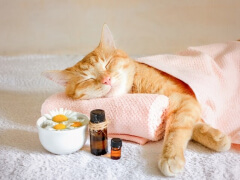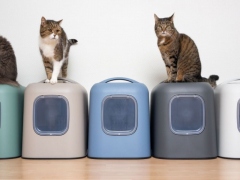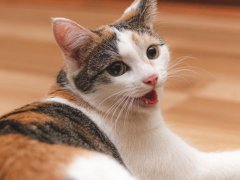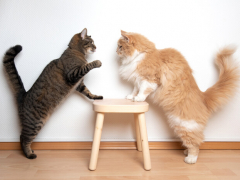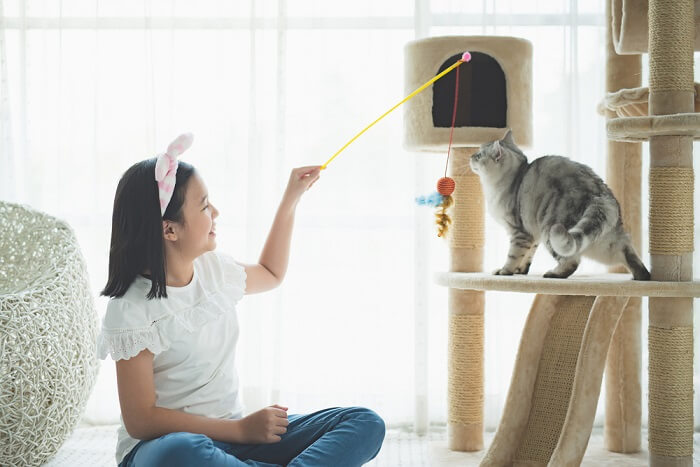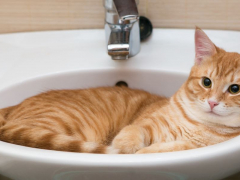
Lizzie Youens / Cats.com
Diabetes mellitus is a condition affecting the body’s amount of the hormone insulin, or its effects on the body. Diabetic cats cannot control their blood sugar levels well, leading to symptoms such as excessive thirst, passing more urine than usual, weight loss and lethargy. Diabetes in cats is usually treated with a combination of insulin injections and strict dietary control.
Feline diabetes is most often seen in middle-aged to older cats, with those over 7 years at higher risk. Owning a senior cat comes with its own trials and complications, so managing an older cat with diabetes can seem daunting, but there are plenty of ways to make diabetic life more manageable for both you and your pet.
As a veterinarian, I’ve seen plenty of diabetic pets over the years, and helped many cat owners navigate their care. Here are my top ten tips for managing senior diabetic cats at home.
1. Food
Diet plays a huge role in the successful management of feline diabetes, and optimal nutrition is also really important for our senior kitties. Getting the right food for a senior diabetic cat is therefore my number one priority as a veterinarian.
The mainstay of any suitable diabetic food is that it is low in carbohydrates. The current recommendation from veterinary research studies is for a low-carbohydrate, high-protein diet with around ≤12–15% of metabolisable energy (ME) carbohydrate and ≥40–45% ME protein content. There are specialized diabetic prescription foods available which meet these requirements. It’s worth noting that wet cat foods are usually lower in carbohydrates compared to dry kibble.
As well as being low-carb, the cat’s food also needs to be palatable to ensure they eat enough to maintain good nutrition. Senior cats need a diet which is easily digestible and contains high quality protein and all the micronutrients needed to optimize health in their later years.
2. Weight Loss

Increased body weight is a risk factor for feline diabetes, and weight loss can help with diabetic control. Lizzie Youens / Cats.com
Obesity is a common risk-factor for diabetes and weight loss is advised for overweight diabetic patients. However, under-eating carries the risk of hypoglycemia (low blood sugar) – especially after insulin dosing.
Weight loss should therefore be done in a careful and controlled manner, with the Royal Veterinary College advising a rate of 0.5-1% of body weight lost per week until a target weight is met. It’s especially important in our senior cats that this weight loss comes from shedding excess body fat, rather than muscle loss. Discuss a weight loss goal with your veterinarian, and book in regular weight checks to keep track of progress.
3. Routine
Cats are creatures of habit, and most enjoy a stable routine of when they feed, play, groom and sleep. A strict schedule is especially important for diabetic cats: insulin injections often need to be given at certain times, and feeding routines may mirror these doses. However, don’t let the perfect become the enemy of the good: the stress of scheduling was reported as a concern for owners in a study on the quality of life of owners of diabetic cats and some flexibility around normal day-to-day life is expected and perfectly manageable.
4. Injections
If you’re anything like the vast majority of diabetic cat owners I have met, it’s the ‘syringes and needles’ bit of a diabetes diagnosis that scares you the most. You are not alone, but with the benefit of experience, I can hand-on-heart say that this is a stumbling block which is very quickly jumped over by most owners. Your first injection will be a little scary. But once you’ve given a few insulin injections, you’ll feel much more confident. And by the time you’ve given fifty – which is after less than a month if your cat is on twice-daily injections like many – you’ll be an absolute pro!
However, as is often the case in veterinary medicine, we have a plan B up our sleeve. In some cases, oral insulin treatments are appropriate – although they are less effective and are not usually recommended as a first-line treatment.
There are lots of different types of insulin, which come with different timing and protocols, so your veterinarian will discuss with you an appropriate treatment plan for your cat. Always talk to your vet if you have any concerns about insulin injection technique or timings, they’ll be happy to advise.
5. Home Monitoring
Diabetic cats need close monitoring to ensure their blood glucose levels are remaining at a stable level and their symptoms are controlled. Your veterinarian will discuss various monitoring techniques that they will use in the clinic, such as blood and urine tests, but owners of diabetic cats play a vital role too. Keeping track of basic diabetic ‘tells’, such as appetite, thirst, body weight and urination is really useful information. Playing close attention to your cat’s habits can also help pick up on any other problems early.
6. Records
Keeping a physical record of your cat’s symptoms, such as their hunger and thirst levels, how often they are going to the litter box and their body weight, is a really useful way for your vet to judge whether they are stable and doing well on their current treatment and diet. This can be as simple as a paper journal, but there are also multiple apps that can be helpful to record all aspects of your cat’s care, to keep you on top of your cat’s medical needs, as well as keeping the veterinary team up to date.
7. Know the Signs

Lethargy, weakness and poor appetite can all be signs of poor diabetic control. Lizzie Youens / Cats.com
When caring for a diabetic cat at home, it’s important to know the signs if your cat’s blood sugar gets too low or too high. Cat’s insulin requirements can change over time – for example, as they age or lose weight – which is why they need close monitoring.
If your cat isn’t getting enough insulin, their blood glucose level will be persistently high (hyperglycemic), leading to the classic symptoms of diabetes: drinking more, urinating more, appetite change and weight loss. Untreated high blood sugar levels can lead to further complications and more severe signs, such as diabetic ketoacidosis and diabetic neuropathy.
If your cat is getting too much insulin, or the insulin isn’t timed correctly with food intake, they may have a hypoglycemic episode (low blood sugar). Symptoms of hypoglycemia in cats include weakness/wobbliness, lethargy, vomiting, muscle twitching, and seizures. If your cat is diabetic and seems quiet, dizzy, or weak, this is an urgent situation that requires an immediate response. Offer them food immediately, or rub something sugary such as honey onto their gums if they won’t eat, and contact your veterinarian.
8. Beware of Complications of Ageing
Older cats are more likely to suffer from certain health conditions, and diabetes makes cats even more vulnerable. Some medical problems, such as hyperthyroidism and kidney disease, are common in older cats but share some of the same symptoms as diabetes in cats, such as weight loss, increased thirst, and changes to urination. Diabetic cats are also more prone to certain problems such as urinary tract infections. This is why close monitoring and record-keeping, as well as regular vet visits, are so important for older diabetic cats.
9. Think of Comfort
Senior diabetic cats are like any other older cat – they need a bit of extra love and care sometimes. Remember to re-evaluate your cat’s environment regularly, especially as they age. Does your older kitty need a little more support with their mobility to get to their favorite places, or a lower-sided litter tray for toileting ease? Perhaps they can no longer jump up onto a counter to be fed or may appreciate a thicker, warmer bed for their ageing joints.
10. Think Positive
Diabetes mellitus is one of the most common hormonal disorders in older cats, and advancements in monitoring and treatment protocols are happening every day. In my thirteen years as a veterinarian, I’ve already seen very positive changes in how we can care for our feline diabetic patients. Although it can seem overwhelming to have an older cat diagnosed with diabetes, your veterinary team is here to support you, and many diabetic cats do very well on a routine of diet and insulin injections, with some even going into remission.


